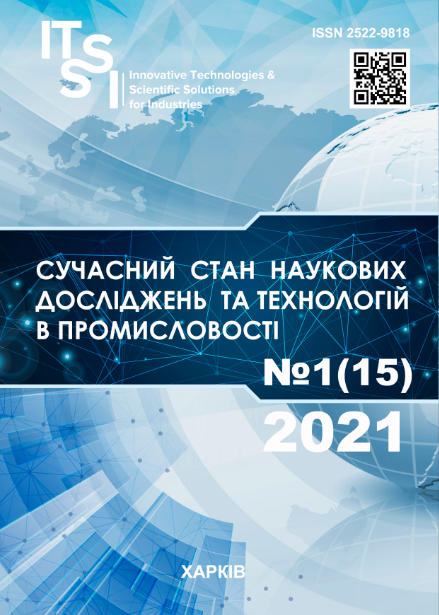TECHNOLOGY FOR CREATING THE TOPOLOGY OF PRINTED CIRCUIT BOARDS USING POLYMER 3D MASKS
DOI:
https://doi.org/10.30837/ITSSI.2021.15.120Keywords:
printed circuit boards, exposure, polymer photomasks, etching solution, LCD printing, regression analysis, topology, conductor image adaptationAbstract
The subject of research is the influence of factors of exposure of two-dimensional images on the topology of conductors in the manufacture of printed circuit boards by the method of three-dimensional polymer photomasks. The purpose of the work is ensuring the accuracy and preservation of the geometric dimensions of the conductors of printed circuit boards during LCD exposure of masks on the work piece. To achieve this goal, it is necessary to solve the following tasks: to analyze photolithography technology and types of polymer 3D printing; to develop a technological process for exposing photopolymer masks to a printed circuit board blank using 3D printing technologies; to conduct experimental studies to determine the optimal exposure parameters; on the basis of the empirical results obtained, to calculate the correlation coefficients of the factors for recall; to construct a linear regression model of the dependence of the deviations of the geometric dimensions of the printed conductors on the parameters of solutions for etching and exposure conditions. Results: The constructed regression models will become the basis for creating a software database that optimizes the initial images of the topology of printed conductors in the automated production of printed circuit boards. This will simplify the process of developing the topology of printed circuit boards, taking into account the real influence of the parameters of the technological operations of etching and exposure on the thickness of the tracks of the conductors of the printed circuit boards, which will reduce the proportion of rejects in the manufacture of single- and double-sided printed circuit boards. Conclusions: an LCD exposure technology and a method for studying the effects of exposure factors on the quality of printed circuit board topology are proposed, which provide sufficient empirical data to create regression models for calculating the influence of technological factors on the final dimensions of conductive paths in the production of printed circuit boards. Further development of the proposed technology will make it possible to manufacture rigid and flexible printed circuit boards completely, with conductive paths, a dielectric base, electronic elements that can be used in various devices.
References
Nevliudov, I., Razumov-Fryziuk, Ye. A., Nevliudova, V., Demska, N. (2016), "Influence mechanical action on flexible printed circuit board", Problems of Friction & Wear, Vol. 1(70), P. 143–149. DOI: 10.18372/0370-2197.1(70).10402
Nevliudov, I. Sh., Tymchuk, I. T., Protsenko, M. A., Demska, N. P. (2018), "The advanced design and technological solutions of ultralight detector modules for physical experiments", Innovative Technologies and Scientific Solutions for Industries, Vol. 3 (5), P. 67–78. DOI: https://doi.org/10.30837/2522-9818.2018.5.067
Vaezi, M., Seitz, H., Yang, S. (2013), "A review on 3D micro-additive manufacturing technologies", The International Journal of Advanced Manufacturing Technology, Vol. 67 (5-8), P. 1721–1754. DOI: https://doi.org/10.1007/s00170-012-4605-2
Pan, Y., Chen, Y. (2016), "Meniscus process optimization for smooth surface fabrication in Stereolithography", Additive Manufacturing, Vol. 12, Part B, P. 321–333. DOI:10.1016/j. addma.2016.05.004
Kumar, S., Bhushan, P., Pandey, M., Bhattacharya, S. (2019), "Additive manufacturing as an emerging technology for fabrication of microelectromechanical systems (MEMS)", Journal of Micromanufacturing, Vol. 2 (2), P. 175–197. DOI: https://doi.org/10.1177/2516598419843688
Mohammed, J. S. (2016), "Applications of 3D printing technologies in oceanography", Methods in Oceanography, Vol. 17, P. 97–117. DOI: 10.1016/j.mio.2016.08.001
"SL/SLA (stereolithography)" ["SL/SLA (stereolytohrafyia)"], available at : https://www.jetcom-3d.ru/technology/stereolithography (last accessed 03.11.2020).
Manapat, J. Z., Chen, Q., Ye, P., & Advincula, R. C. (2017), "3D printing of polymer nanocomposites via stereolithography", Macromolecular Materials and Engineering, Vol. 302 (9), P. 1600553. DOI: https://doi.org/10.1002/mame.201600553
"DLP (Digital Light Processing)" ["DLP (Digital Light Processing"], available at : https://www.jetcom-3d.ru/technology/digital-light-processing (last accessed 03.11.2020).
Jacobsen, A., Jorgensen, T., Tafjord, Kirkhorn, E. (2015), "Concepts for 3D print productivity systems with advanced DLP photoheads", In Emerging Digital Micromirror Device Based Systems and Applications VII, International Society for Optics and Photonics, Vol. 9376, P. 937605. DOI: https://doi.org/10.1117/12.2084962
"Modern photopolymer printers 3D printers: laser, DLP, LCD" ["Sovremennыe fotopolymernыe prynterы 3D-pryntery: lazernye, DLP, LCD"] available at : https://3dtoday.ru/blogs/pl32/modern-photopolymer-3d-printersprinters-laser-dlp-lcd (last accessed 05.11.2020).
Shen, J. Y. H., & Tan, Z. X. (1999), "Curing characteristics of acrylic photopolymer used in stereolithography process", Rapid Prototyping Journal, Vol. 5 (1), P. 27–34. DOI: https://doi.org/10.1108/13552549910251855
Andrzejewska, E. (2001), "Photopolymerization kinetics of multifunctional monomers", Progress in Polymer Science, Vol. 26, No. 4, P. 605–665. DOI: 10.1016/S0079-6700(01)00004-1
Huang, Y.-M., Kuriyama, S., Jiang, C.-P. (2004), "Fundamental study and theoretical analysis in a constrained-surface stereolithography system", The International Journal of Advanced Manufacturing Technology, Vol. 24, No. 5-6, P. 361–369. DOI: 10.1007/s00170-003-1627-9
Dubnov, P. Yu. (2004), Processing statistical information using SPSS [Obrabotka statystycheskoi ynformatsyy s pomoshchiu SPSS], Moscow : NT Press, 221 p.
Downloads
Published
How to Cite
Issue
Section
License

This work is licensed under a Creative Commons Attribution-NonCommercial-ShareAlike 4.0 International License.
Our journal abides by the Creative Commons copyright rights and permissions for open access journals.
Authors who publish with this journal agree to the following terms:
Authors hold the copyright without restrictions and grant the journal right of first publication with the work simultaneously licensed under a Creative Commons Attribution-NonCommercial-ShareAlike 4.0 International License (CC BY-NC-SA 4.0) that allows others to share the work with an acknowledgment of the work's authorship and initial publication in this journal.
Authors are able to enter into separate, additional contractual arrangements for the non-commercial and non-exclusive distribution of the journal's published version of the work (e.g., post it to an institutional repository or publish it in a book), with an acknowledgment of its initial publication in this journal.
Authors are permitted and encouraged to post their published work online (e.g., in institutional repositories or on their website) as it can lead to productive exchanges, as well as earlier and greater citation of published work.














